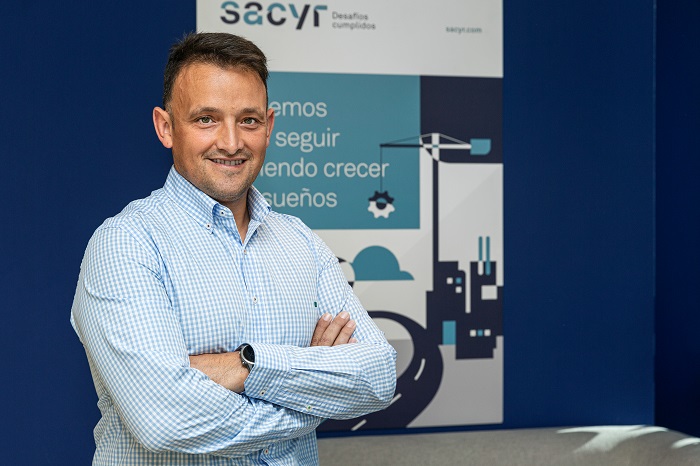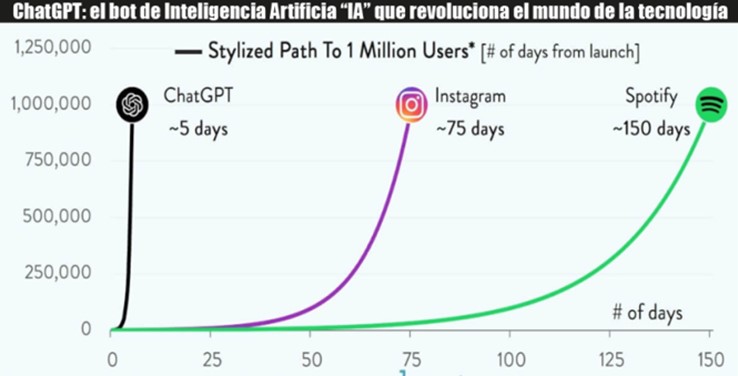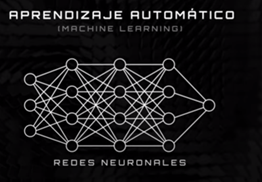OSCAR CUEVAS / IT Department
Disclaimer: this article was originally written in Spanish and translated using ChatGPT. This was later reviewed by an editor. Enjoy!
The artificial intelligence tool ChatGPT has become extremely popular in a short amount of time. Everyone is using it and it achieved the staggering figure of 10 million active users per day in its first month. Millions of users ask ChatGPT every day, a technology that has broken the record for the technology that was adopted the fastest, with a growth rate 10 times faster than that of Instagram.
It works like a chat that you can ask all kinds of things: a kind of technological oracle that can tell you all sorts of things: the best way to tie your shoes; how you should break up with your boyfriend or girlfriend in the gentlest way possible; how to write software; compose a song with its corresponding chords; or create a confidentiality agreement. And it remembers everything you've talked about throughout the conversation.

But what is ChatGPT really?
ChatGPT was developed by OpenAI, an artificial intelligence research company founded in 2015 by Elon Musk, Hoffman, who is the co-founder of LinkedIn, Peter, who is the co-founder of PayPal, and other prominent people.
OpenAI has specialized in developing advanced language models, and ChatGPT is one of its most popular and successful products. ChatGPT, Generative Pre-training Transformer, is defined as a generative language model that is used for the automatic creation of text.
If we put it in more colloquial language, we could say that it is a word predictor, similar to what mobile phones do when we write a message, but conditioned to take into account that our text is a question and the response it generates for us is the string of words that are most likely, according to its system, to appear next. That is, it predicts text.
Based on GPT-3.5, it uses a deep neural network and a machine learning algorithm for text production that can realistically imitate human language.
But what is a neural network? Let's take a look.
A neural network is a program designed to learn how to perform tasks. Normally, when humans want to talk to a computer and ask it to do something, we program and tell the machine exactly step by step what it has to do.
But there are some things that we don't know very well how to explain. For example, recognizing a handwritten number. There are thousands of ways to write numbers by hand; let's imagine the drawing of a cat, how many ways are there to draw a cat?
These are tasks that as humans we know how to do easily but are difficult to explain to a program.
For all of these things that we don't know how to program, we have invented machine learning and neural networks.
We prepare this neural network to know where it should look, what points are interesting in this data, what kind of operations it should perform with them so that it can draw conclusions. But it will be the neural network itself that, based on studying many cases and a lot of data, will try to understand what needs to be done in each of them so that it can draw its own conclusions.
If we look at our neural network, we can think of each point as what is known as a parameter. To give you an idea, the GPT-3 model, in particular, has a size of 175 billion parameters, making it the largest language model ever trained.
As we said, the network needs to learn and in the case of GPT-3 it was trained with a set of texts that included over 8 billion documents and more than 10 billion words.
From this text, the model learns to perform natural language processing tasks, achieving the ability to understand and generate language as a human would.
GPT is a system that has been trained to hold conversations with anyone in any language you write to it in. Its algorithms analyze the words you write, understand their order, meaning, and interpret what you want to say, then generate a response based on the information it has been trained with. As it collects more information, Chat GPT modifies the information with which it is trained and learns.
Thus, we can say that Open Chat GPT lives in constant update with new data and acquires a set of skills to automatically perform the task it is assigned. Inside this model, we find the architecture known as Transformer, a processing technique introduced by Google in 2017. It works through layers, which convert each word into numerical vectors that can then be mathematically processed by a neural network.

How to use it and a few important considerations
To use this platform, you need to go to its official website chat.openai.com and, if it is your first time accessing it, you need to create an account with an email address. Currently, we have three ways to use it:
The first is to subscribe to the ChatGPT Plus service, which costs $20 per month and allows you to interact with the options of the new GPT 4 engine. We can still use the basic and free version of ChatGPT, but it is still based on GPT-3.5.
Lastly, use Bing with ChatGPT, Microsoft's new search engine that offers this conversational option. This engine is also based on GPT-4 and can be used for free by requesting access to the service.
It is important to note that everything requested from Chat GPT is recorded and used by its developers to continue improving and advancing the tool. Therefore, it is recommended that if you want to maintain privacy online, do not share personal data.
For this same reason, NO business account should be used to sign up or use professional data.
In fact, in Italy, they have decided to block the use of ChatGPT, indicating that "OpenAI does not provide information to users or interested parties whose data it collects. And most importantly, there seems to be no legal basis that justifies the massive collection and processing of personal data to 'train' the algorithms on which the platform is based."
The Italian agency also insists that, although OpenAI's service is supposedly aimed at people over 13 years old, there is no age verification mechanism for users. "It exposes children to receive answers that are absolutely inappropriate for their age and knowledge."

Future of Chat GPT
As the main update compared to the third version, its "multimodal" nature stands out. Instead of working solely with text, GPT-4 is also capable of accepting images as input. That is, we can upload images to give visual instructions. However, the results will always be presented to us in textual format.
It is worth noting that OpenAI has been very cautious and has refused to provide an estimate of the number of parameters used in GPT-4. Some experts suggest that the evolution of the model has not necessarily been achieved by increasing the number of parameters. A major limitation would be that the required computing power would cost millions of dollars per hour.
